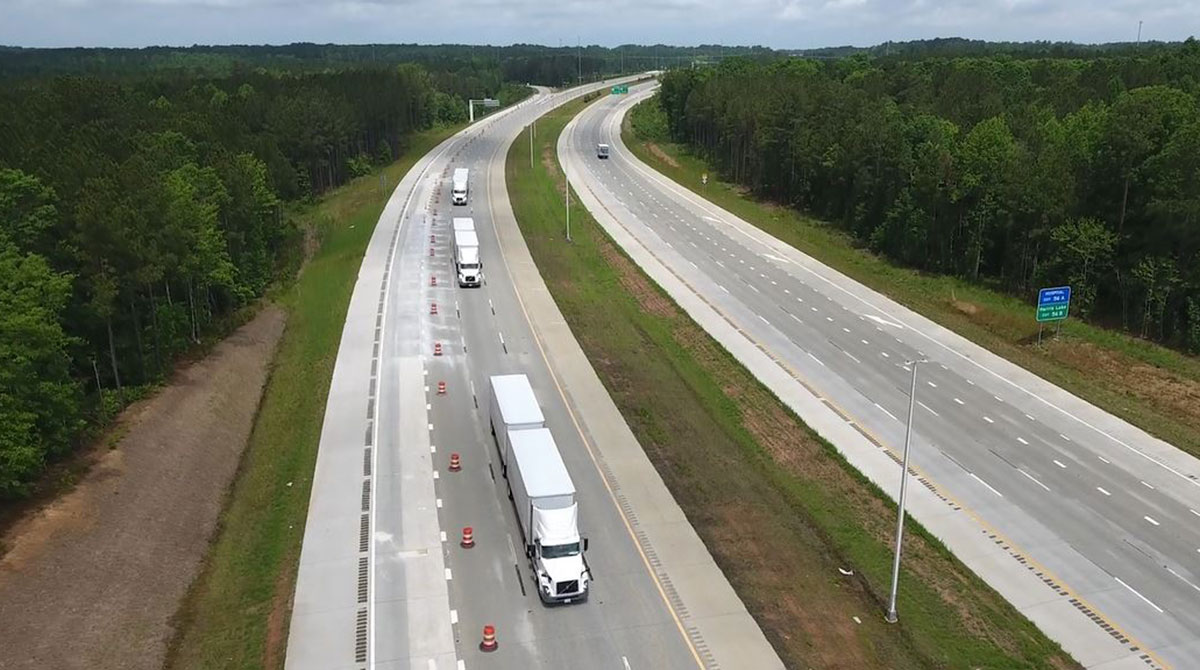Share
June 27, 2018 1:00 PM, EDT
Volvo, FedEx Team on Live Platooning in North Carolina
 Volvo, in collaboration with FedEx Corp. and the North Carolina Turnpike Authority, demonstrates on-highway truck platooning on N.C. Route 540. (Volvo Trucks North America)
Volvo, in collaboration with FedEx Corp. and the North Carolina Turnpike Authority, demonstrates on-highway truck platooning on N.C. Route 540. (Volvo Trucks North America)
Volvo Trucks North America and FedEx Corp. demonstrated on June 27 a platooning system with three twin trucks on a stretch of Route 540 in North Carolina, one of 10 official test sites for driverless cars designated in 2017 by the U.S. Department of Transportation.
The three trucks traveled for 18 miles in the demonstration, moving in and out of traffic as vehicles cut between the platoon and using ramps to enter and exit the highway.
Professional truck drivers in Volvo VNL tractors were used in the demonstration, each pulling double 28-foot trailers. The tractors communicated using what Volvo calls Cooperative Adaptive Cruise Control, a wireless vehicle-to-vehicle communication technology.
The two collaborators have been testing the platooning system that uses Volvo technology with the North Carolina Turnpike Authority since April. This marks the first public on-highway showcase of platooning technology between a major truck manufacturer and a transportation company in the United States, according to Volvo.
The project in North Carolina used Volvo engines and transmissions along with Bendix brakes.
In the demonstration, the driver in the lead vehicle controlled the brakes of the two following trucks. The drivers in the following trucks must keep their hands on the wheel and ensure their vehicle stays in its lane.

Incoming CEO John Smith said FedEx Freight participated in the test because platooning can reduce fuel use, improve the driver experience and make truck driving more efficient. (Burney Simpson/Transport Topics)
The tractors and trailers traveled at speeds of up to 62 mph while keeping a time gap of 1.5 seconds, a closer gap than is typical for Class 8 trucks on highway.
While the close distance may be considered risky, Volvo contends that the technology is safer than typical highway driving. The V2V system allows for the lead truck to hit its brakes and simultaneously transmit a command to the following trucks to brake. Their braking response is nearly instantaneous and much faster than the typical human driver reaction time to a sudden braking event, according to Volvo.
Platooning also has proved to reduce fuel use because it reduces drag between the trucks.
At a 40- to 50-foot following distance, the system can reduce fuel use by 4% for the lead truck and 10% for the following truck, for a combined 7% reduction, according to the North American Council for Freight Efficiency. The National Renewable Energy Laboratory has found that a two-truck platoon can realize team fuel reduction of 6.4%.
Volvo declined to share fuel savings seen during its test in North Carolina.
N.C. Highway 540 is part of the beltway around Raleigh and is overseen by the North Carolina Turnpike Authority. Volvo North America’s headquarters is in Greensboro, N.C., about an hour from the test site.
The Volvo test is using dedicated short-range communication that allows for the V2V communications. A portion of the public bandwidth of radio waves has been reserved for DSRC use to promote highway safety.
“Dedicated bandwidth within the 5.9 GHz spectrum is critical for the successful deployment of V2V application, like truck platooning,” said Keith Brandis, VTNA vice president for product planning.
Mountain View, Calif.-based Peloton Technology may be the best-known platooning proponent. In December, it completed successful tests of its two-truck platooning system in Florida and Michigan, and an executive told Transport Topics that it expects its technology to be operating commercially by the end of this year.
Volvo is a Peloton shareholder but it is looking at multiple solutions for platooning technology, Brandis said.
Daimler Trucks this month opened an automated truck research and development center at its North American headquarters in Portland, Ore., and demonstrated its prototype two-truck platooning system with automated steering capabilities at the Portland International Raceway.
Like Volvo, the Daimler system uses V2V communications to coordinate braking activity between the trucks, enabling the second truck to travel at a closer-than-usual distance that reduces aerodynamic drag and boosts fuel economy. The following distance was 15 meters in a demonstration at the raceway.
Daimler said that V2V allows the trailing truck to automatically brake in less than three-tenths of a second.

No comments:
Post a Comment